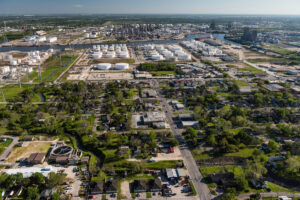
New Report Shows Latino, Black, and Low-Income Neighborhoods Suffer Most as 2023 is Worst Year for Ozone Since 2011
For audio of the press conference, click here for part 1 and here for part 2.
HOUSTON – Air monitoring data show that communities of color and lower-income neighborhoods were the hardest hit as the Houston region in 2023 suffered its worst year for smog in more than a decade, according to a new report by the Environmental Integrity Project.
Scorching temperatures combined with air pollution—including from an expanding oil and gas industry— to trigger an increase in ozone across the Houston region in recent years. Air quality monitors measured ozone levels that violated health-based standards on 55 days in 2023, more than any other year since 2011, and the neighborhoods with the worst smog were often largely Latino, African-American or lower-income. (Click here for an online map with data.)
The Environmental Integrity Project (EIP) report found that 22 of 36 Houston-area air monitors recorded levels of ozone that violated the most recent federal ozone standards in 2021-2023, using the three-year average that EPA employs to determine compliance with federal ozone rules. The standards (70 ppb) were established in 2015, during the Obama Administration.
But the report also highlights the top 10 locations in the greater Houston area where ozone levels were so high, they also violated less stringent standards (75 ppb) put in place by the Bush Administration in 2008. People of color made up 76 to 94 percent of those living within three miles of all but one of the nine Harris County monitors, and about two-thirds of residents within three miles of the Brazoria County monitor, just south of Harris County. The percentage of low-income residents in six of the ten neighborhoods surrounding these monitors ranges from 43 to 53 percent, well above the statewide average of 34 percent.
“Texas Governor Greg Abbott has been doing less than nothing to address this public health threat – in fact, he recently wrote to the EPA to complain about Houston being upgraded to ‘serious’ nonattainment of federal ozone standards,” said Eric Schaeffer, Executive Director of the Environmental Integrity Project.
“The people of Houston deserve stronger protections – including by giving Harris County and surrounding jurisdictions the power to form an independent air pollution control agency, so they can crack down on polluters if the state of Texas will not,” said Schaeffer, former director of civil enforcement at EPA.
Dr. Inyang Uwak, Research and Policy Director at Air Alliance Houston, said: “Houston continues to be in non-attainment of the National Ambient Air Quality Standards for ozone pollution. This report reveals the worsening ozone levels and the deepening environmental injustices prevalent in our communities of color who continue to bear the greatest impact of ozone pollution. Our community air monitoring efforts in some of these communities confirm these alarming trends, emphasizing the dire need for our state regulatory agency to take a more proactive approach to address Houston’s smog problem.”
Dr. Loren Hopkins, Chief Environmental Science Officer for the Houston Health Department, said: “The Houston Health Department is very concerned about these high ozone levels, not only because they occur in environmental justice communities, but also because these same communities suffer from asthma attacks and cardiac arrest at higher rates than the rest of the city. We continue to seek out emission sources of pollutants that are the precursors to ozone such as formaldehyde, benzene, and 1,3 butadiene. We would welcome TCEQ working with us to lower these ozone precursors.”
EIP’s report, which is based on data from the Texas Commission on Environmental Quality and EPA, also found the following:
- Smoggiest Days in 2023: In Harris County, six air quality monitors recorded ozone levels in 2023 ranging from 100 to 114 parts per billion (ppb), far above the most recent federal ozone limits (70 ppb). People of color accounted for more than 90 percent of residents within three miles of four of these monitoring locations, mostly east of downtown along the Houston Ship Channel, including in the Galena Park and Clinton Park neighborhoods. About half the population in each of these high-smog areas live in low-income households.
- Smog Worse or Unchanged Since 2008-2010: After declining in the 1990s and early 2000s, smog in Houston has been growing worse over the last decade. Ozone levels at six of the locations that exceeded the 2008 (75 ppb) standard in 2021–2023 are either unchanged or higher than the three-year average in 2008–2010. The percentage of people of color and those with low income who live near these places are far higher than either the state or county average.
- Most Daily Smog Events: EIP’s report also looked at how many days the ozone standard was exceeded at various locations in the greater Houston area. People of color accounted for a disproportionate share of those living within three miles of six of ten monitors reporting the most days above the 70 ppb ozone limit from 2021 through 2028, with a higher than average number of low-income residents at five of these locations.
As potential solutions, the EIP report recommends that EPA increase its oversight of Texas regulators – who so far have been failing to address the problem, especially emissions from the oil, gas, and petrochemical industries – and vigorously enforce the Clean Air Act by cracking down on smog-forming pollutants.
The report also calls for structural reform, by empowering Harris County and other local governments to protect their own air quality and form an independent Houston regional air pollution control authority, instead of having to rely on the Texas Commission on Environmental Quality.
For a copy of the report, click here.
Media contact: Tom Pelton, Environmental Integrity Project (443) 510-2574 or tpelton@environmentalintegrity.org
Photo by Garth Lenz of the International League of Conservation Photographers


